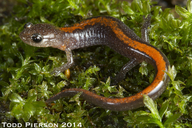|
Plethodon angusticlavius Grobman, 1944
Ozark Salamander, Ozark Zigzag Salamander Subgenus: Plethodon | family: Plethodontidae subfamily: Plethodontinae genus: Plethodon |
 © 2014 Todd Pierson (1 of 11) |
|
|
Country distribution from AmphibiaWeb's database: United States
U.S. state distribution from AmphibiaWeb's database: Arkansas, Missouri, Oklahoma
Plethodon angusticlavius Grobman, 1944 Walter E. Meshaka Jr.1 1. Historical versus Current Distribution. Ozark zigzag salamanders (Plethodon angusticlavius) are distributed throughout the Ozark Plateaus Province, from northwestern Arkansas to the eastern edge of Oklahoma and the southern tip of Missouri (Thurow, 1966). Their current distribution is not thought to be different from their historical distribution. 2. Historical versus Current Abundance. Unknown, although population declines have not been noted. 3. Life History Features. A. Breeding. Reproduction is terrestrial. i. Breeding migrations. In Arkansas, adults migrate to sandstone cedar glades from the forest during the courting season. Courtship activities among Ozark zigzag salamanders occur in the cool wet winter to spring. Vasa deferentia are largest from January–April, and yolked follicles are present January–May (Meshaka and Trauth, 1995). ii. Breeding habitat. Clutches of closely related northern zigzag salamanders (Plethodon dorsalis) are deposited within rock crevices, subterranean cavities, and in caves (Mohr, 1952; Smith, 1961; Mount, 1975; Miller et al., 1998). Logs appear to be avoided as nesting sites. Eggs rest on the substrate and are attended by the female (Mohr, 1952; Miller et al., 1998). B. Eggs. i. Egg deposition sites. Clutches of closely related northern zigzag salamanders are deposited within rock crevices, subterranean cavities, and in caves (Mohr, 1952; Smith, 1961; Mount, 1975; Miller et al., 1998). Logs appear to be avoided as nesting sites. Eggs rest on the substrate and are attended by the female (Mohr, 1952; Miller et al., 1998). ii. Clutch size. Ozark zigzag salamander clutches in Arkansas average 5.3 eggs (range 3–9) and are produced annually (Meshaka and Trauth, 1995). Hatchlings appear in the fall (Wilkinson et al., 1993; Meshaka and Trauth, 1995). C. Direct Development. i. Brood sites. Within rock crevices and underground. ii Parental care. Females attend the nest during the summer when they are absent from foraging sites (Wilkinson et al., 1993; Meshaka and Trauth, 1995). D. Juvenile Habitat. Same as adults. E. Adult Habitat. Ozark zigzag salamanders are found in moist leaf litter, talus areas, and caves (Thurow, 1955; Meshaka and Trauth, 1995). Rocky habitat is preferred (Smith, 1961, Reinbold, 1979). This habitat serves to buffer them from weather extremes and enhance population sizes. The availability of these rocky habitats therefore limits the abundance of Ozark zigzag salamanders (Petranka, 1979). Rocky cedar glades are used extensively by adults during the courtship season (Meshaka and Trauth, 1995). F. Home Range Size. Unknown. G. Territories. Unknown. H. Aestivation/Avoiding Dessication. Aestivation is unknown; animals likely avoid dessicating conditions by moving under cover objects or into burrows. I. Seasonal Migrations. In Arkansas, adults migrate to sandstone cedar glades from the forest during the courting season (see "Breeding migrations" above). Immature animals are not found on the glade (Meshaka and Trauth, 1995). J. Torpor (Hibernation). Unknown. K. Interspecific Associations/Exclusions. Centipedes in the genus Scolopendra sp., which are potential predators, were found in the same leaf litter as Ozark zigzag salamanders (Meshaka and Trauth, 1995). L. Age/Size at Reproductive Maturity. Both sexes mature at 35 mm SVL and reproduce for the first time in the winter of their third year of life (Meshaka and Trauth, 1995). M. Longevity. Unknown. N. Feeding Behavior. Spiders and beetles comprised most of the diet of a fall and winter sample of closely related northern zigzag salamanders (Holman, 1955). O. Predators. Scolopendra sp. are likely predators (personal observations). P. Anti-Predator Mechanisms. Unknown. Q. Diseases. Unknown. R. Parasites. Chiggers of the genus Hannemania have been reported from Ozark zigzag salamanders (Duncan and Highton, 1979). 4. Conservation. Ozark zigzag salamanders have a relatively small geographic range, which by itself is cause for concern. Additionally, little is known about their ecology, and therefore risks to populations through perturbations of their mesic woodland habitat can only be approximated. Acknowledgments. Richard Highton reviewed this account and provided valuable feedback. 1Walter E. Meshaka Jr. Current address: Literature references for Amphibian Declines: The Conservation Status of United States Species, edited by Michael Lannoo, are here. Feedback or comments about this page.
Citation: AmphibiaWeb. 2024. <https://amphibiaweb.org> University of California, Berkeley, CA, USA. Accessed 16 Apr 2024. AmphibiaWeb's policy on data use. |




 Raffaëlli Account
Raffaëlli Account Map of Life
Map of Life